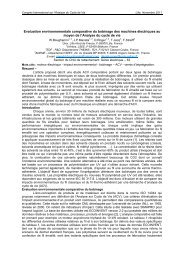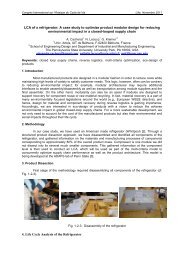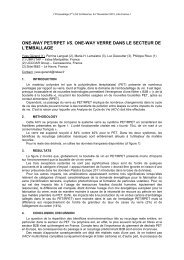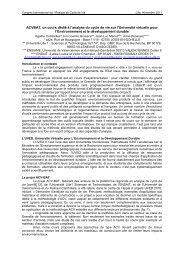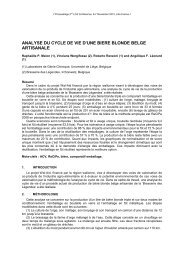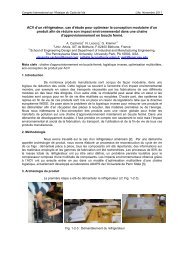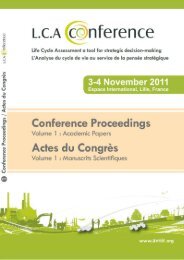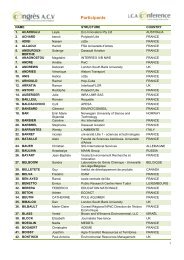Assessing Temporary Carbon Storage in Life Cycle Assessment and ...
Assessing Temporary Carbon Storage in Life Cycle Assessment and ...
Assessing Temporary Carbon Storage in Life Cycle Assessment and ...
Create successful ePaper yourself
Turn your PDF publications into a flip-book with our unique Google optimized e-Paper software.
With reduced uptake the atmospheric CO 2 content trends upwards aga<strong>in</strong>, <strong>and</strong> 20 years after the <strong>in</strong>itial<br />
removal, the atmospheric content is lowered by only about half as much as the <strong>in</strong>itial amount removed.<br />
Extra s<strong>in</strong>k<br />
(tC)<br />
Temperature<br />
difference (10 -12 K)<br />
0.0<br />
-0.5<br />
-1.0<br />
0<br />
-1<br />
-2<br />
2000 2020 2040 2060 2080 2100<br />
2000 2020 2040 2060 2080 2100<br />
0.5<br />
0.0<br />
-0.5<br />
-1.0<br />
Difference <strong>in</strong> atmospheric<br />
carbon content (tC)<br />
Extra s<strong>in</strong>k<br />
(tC)<br />
Temperature<br />
difference (10 -12 K)<br />
0.0<br />
-0.5<br />
-1.0<br />
0<br />
-1<br />
-2<br />
2000 2020 2040 2060 2080 2100<br />
2000 2020 2040 2060 2080 2100<br />
0.5<br />
0.0<br />
-0.5<br />
-1.0<br />
Difference <strong>in</strong> atmospheric<br />
carbon content (tC)<br />
Figure 7.4.2: The effect of s<strong>in</strong>k activity on atmospheric CO2 concentration <strong>and</strong> resultant temperature. The Figure on the left<br />
shows the effect of a permanent s<strong>in</strong>k, <strong>and</strong> the Figure on the right, the effect of a s<strong>in</strong>k created <strong>in</strong> 2000 <strong>and</strong> reversed aga<strong>in</strong> <strong>in</strong><br />
2020. All curves show the change as a consequence of the s<strong>in</strong>k activity. These changes are therefore additional to any CO2<br />
or temperature changes that may be occurr<strong>in</strong>g due to other factors (such as fossil-fuel emssions).<br />
If carbon storage is only temporary <strong>and</strong> is reversed after 20 years (the p<strong>in</strong>k l<strong>in</strong>e <strong>in</strong> Figure 7.4.2, right<br />
panel) then the atmospheric carbon content <strong>in</strong>creases by 1 tonne aga<strong>in</strong> at the time of the carbon release.<br />
However, because the atmospheric content has <strong>in</strong>creased over the time with reduced ocean uptake, the<br />
ultimate CO 2 content is greater than it would have been if there had been no temporary storage. That<br />
elevation <strong>in</strong> atmospheric carbon content is most pronounced immediately after the re-release of stored<br />
carbon <strong>and</strong> then trends back down towards the 0 l<strong>in</strong>e.<br />
Changes <strong>in</strong> CO 2 concentration then have radiative forc<strong>in</strong>g properties <strong>and</strong> affect global temperatures.<br />
Because of thermal <strong>in</strong>ertia, temperature does not follow radiative forc<strong>in</strong>g immediately, but only with<br />
some further delay. That has been modelled here with a simple 10-year time constant. The effect of<br />
different thermal delay constants has been explored to some extent by Kirschbaum (2003a).<br />
Importantly, follow<strong>in</strong>g establishment of permanent carbon s<strong>in</strong>ks, temperature is reduced the most<br />
about a decade after the s<strong>in</strong>k activity <strong>and</strong> dim<strong>in</strong>ishes thereafter. Follow<strong>in</strong>g the establishment of<br />
temporary s<strong>in</strong>ks, temperature is reduced while carbon is stored, but temperature then <strong>in</strong>creases aga<strong>in</strong><br />
<strong>and</strong> ultimately is higher than it would have been without the use of temporary carbon s<strong>in</strong>ks. The<br />
ultimate warm<strong>in</strong>g effect is greatest about 20 years after the re-release of carbon, <strong>and</strong> <strong>in</strong>creases with the<br />
length of carbon storage.<br />
41



